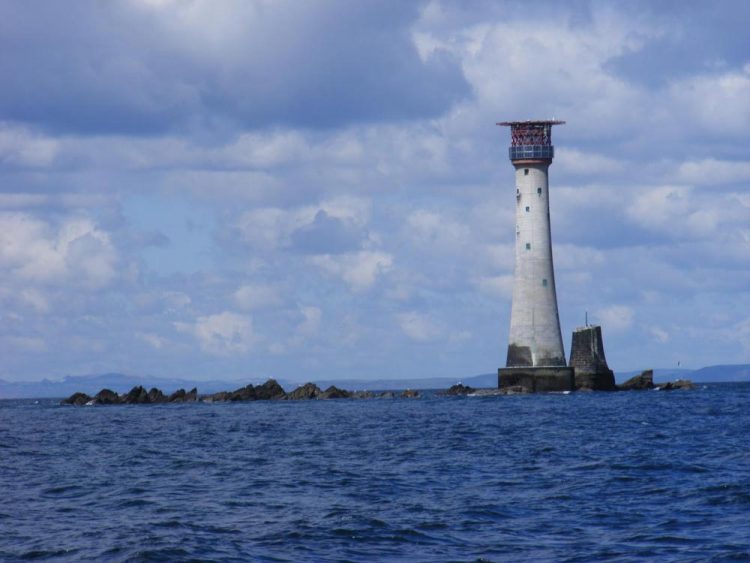Pilot study reveals storm response of offshore lighthouses

The Douglass Tower is on the Eddystone Reef off the coast of South West England. Credit: Helen Nance/Plymouth University
A team from the School of Marine Science and Engineering considered historical and contemporary observations of the wave impact loading on rock lighthouses during storm conditions.
They combined these with data obtained in a pilot study on the Eddystone Lighthouse during the winter of 2013/14, and found the motion of the tower was smaller than might have been suggested by anecdotal observations.
However, the waves still pose a threat with measurements showing they climbed up to 40 metres up the side of a structure not regarded among the most vulnerable lighthouses in the British Isles, let alone globally.
The study, published in the journal Maritime Engineering, was led by Dr Alison Raby, Associate Professor (Reader) in Coastal Engineering at Plymouth University.
She said: “There are about 20 masonry lighthouses around the UK that are exposed to wave action. Although mariners are making ever greater use of satellite-based navigation technologies, the General Lighthouse Authorities recognise the need to retain rock lighthouses as physical aids to navigation. However, there is concern about how well they would withstand the additional wave loading associated with predicted sea level rises and increased storminess.”
To assess current impacts, Plymouth University technicians installed a range of measuring equipment on the Douglass tower, the fourth lighthouse sited on the Eddystone Reef (around 14 miles off the coast of Plymouth) and in situ since 1882.
These included remote-controlled video cameras to record the wave conditions around the structure, together with geophone systems to measure any structural response.
Lighthouse engineers working on two other structures off the South West coast – Wolf Rock and Bishop Rock – also provided reports of the visual and physical effects of the storm, much as engineers have done for centuries.
The equipment recorded 2,978 individual events between 20 December 2013 and 14 March 2014, with a maximum wind speed in excess of 100mph and waves spreading up the face at a maximum of 50 metres per second.
Vibration measurements from the geophones gave maximum velocities of 5.5mm/s and highest displacements of around 0.07mm.
A structural model of the tower, validated by these field data, has been used to assess its stability and confirms the tower is within the safe limits for the worst wave measured during these storms.
However, more work is needed to ensure the stability of other rock towers to even more dramatic wave impacts, and funds to extend this research have been sought.
Dr Raby adds: “People look at lighthouses and wonder how they can absorb such colossal wave impacts. It is possible the current Eddystone Lighthouse responds less than other lighthouses, but while the cylindrical base of the lighthouse may reduce the wave run-up, video data shows it does not prevent water from jetting up above 40 metres. In this case, designers have potentially learned from previous mistakes, but this is far from the most exposed rock lighthouse and the curious effect of the particular rocky outcrops will mean other lighthouse responses to wave impacts will be quite different.”
The results of further tests using the COAST laboratory at Plymouth University and a computational study are currently being analysed, while more advanced equipment is being fitted to Eddystone and additional instruments are being deployed at the Longships Lighthouse off Land's End.
Dr Raby will also be presenting the research at the annual International Association of Lighthouse Authorities' Engineering meeting in Paris in April 2016.
Media Contact
All latest news from the category: Earth Sciences
Earth Sciences (also referred to as Geosciences), which deals with basic issues surrounding our planet, plays a vital role in the area of energy and raw materials supply.
Earth Sciences comprises subjects such as geology, geography, geological informatics, paleontology, mineralogy, petrography, crystallography, geophysics, geodesy, glaciology, cartography, photogrammetry, meteorology and seismology, early-warning systems, earthquake research and polar research.
Newest articles

Properties of new materials for microchips
… can now be measured well. Reseachers of Delft University of Technology demonstrated measuring performance properties of ultrathin silicon membranes. Making ever smaller and more powerful chips requires new ultrathin…

Floating solar’s potential
… to support sustainable development by addressing climate, water, and energy goals holistically. A new study published this week in Nature Energy raises the potential for floating solar photovoltaics (FPV)…

Skyrmions move at record speeds
… a step towards the computing of the future. An international research team led by scientists from the CNRS1 has discovered that the magnetic nanobubbles2 known as skyrmions can be…




















